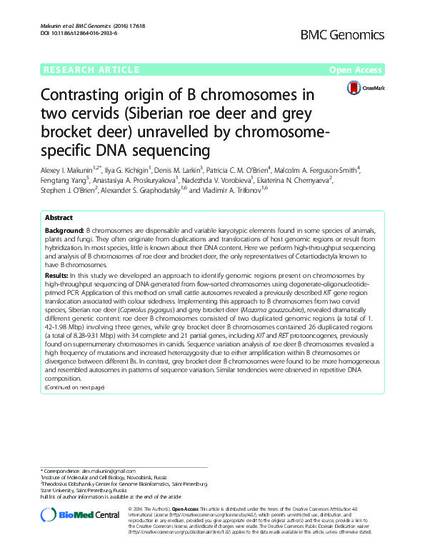
- B chromosome evolution,
- High-throughput sequencing,
- DOP-PCR,
- Siberian roe deer,
- Grey brocket deer,
- Protooncogenes
Background
B chromosomes are dispensable and variable karyotypic elements found in some species of animals, plants and fungi. They often originate from duplications and translocations of host genomic regions or result from hybridization. In most species, little is known about their DNA content. Here we perform high-throughput sequencing and analysis of B chromosomes of roe deer and brocket deer, the only representatives of Cetartiodactyla known to have B chromosomes. Results
In this study we developed an approach to identify genomic regions present on chromosomes by high-throughput sequencing of DNA generated from flow-sorted chromosomes using degenerate-oligonucleotide-primed PCR. Application of this method on small cattle autosomes revealed a previously described KIT gene region translocation associated with colour sidedness. Implementing this approach to B chromosomes from two cervid species, Siberian roe deer (Capreolus pygargus) and grey brocket deer (Mazama gouazoubira), revealed dramatically different genetic content: roe deer B chromosomes consisted of two duplicated genomic regions (a total of 1.42-1.98 Mbp) involving three genes, while grey brocket deer B chromosomes contained 26 duplicated regions (a total of 8.28-9.31 Mbp) with 34 complete and 21 partial genes, including KIT and RETprotooncogenes, previously found on supernumerary chromosomes in canids. Sequence variation analysis of roe deer B chromosomes revealed a high frequency of mutations and increased heterozygosity due to either amplification within B chromosomes or divergence between different Bs. In contrast, grey brocket deer B chromosomes were found to be more homogeneous and resembled autosomes in patterns of sequence variation. Similar tendencies were observed in repetitive DNA composition. Conclusions
Our data demonstrate independent origins of B chromosomes in the grey brocket and roe deer. We hypothesize that the B chromosomes of these two cervid species represent different stages of B chromosome sequences evolution: probably nascent and similar to autosomal copies in brocket deer, highly derived in roe deer. Based on the presence of the same orthologous protooncogenes in canids and brocket deer Bs we argue that genomic regions involved in B chromosome formation are not random. In addition, our approach is also applicable to the characterization of other evolutionary and clinical rearrangements.
Available at: http://works.bepress.com/stephen-obrien/675/

© 2016 The Author(s). Open Access This article is distributed under the terms of the Creative Commons Attribution 4.0 International License (http://creativecommons.org/licenses/by/4.0/), which permits unrestricted use, distribution, and reproduction in any medium, provided you give appropriate credit to the original author(s) and the source, provide a link to the Creative Commons license, and indicate if changes were made. The Creative Commons Public Domain Dedication waiver (http://creativecommons.org/publicdomain/zero/1.0/) applies to the data made available in this article, unless otherwise stated.